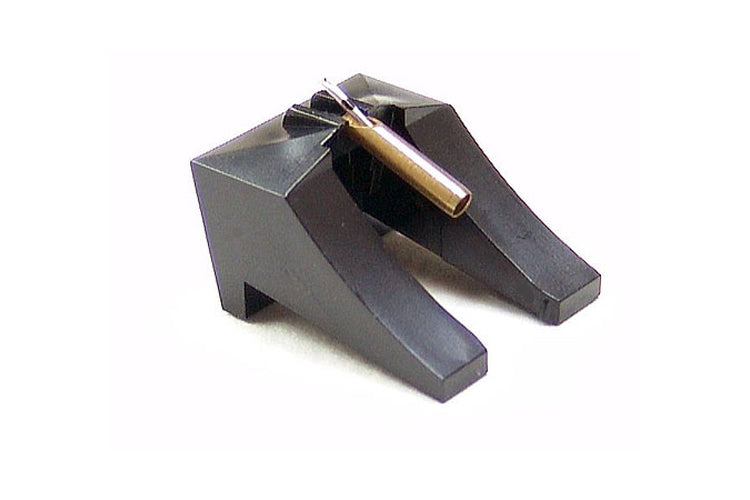
About The National Technics EPS 207
Audio Trends can help you with a high quality replacement stylus. Note, we don't call them needles! That's is what was used to play 78's on the old gramophones. Our range of styli (plural for stylus) suits both old and new cartridges and it would be rare if we couldn't provide you a solution.
The National Technics stylus features a highly polished spherical diamond for long playing life, excellent tracing of record grooves and superb rendition of voice and music. The stylus is made by the world's largest manufacturer of generic stylii.
Generic Version: This description is for a generic version (not original OEM) but is made by the world's biggest maker of generic styli in Japan who have an excellent reputation for making accurate and great sounding products. It features a highly polished spherical diamond for long playing life, excellent tracing of record grooves and superb rendition of voice and music.
Replaces National/Technics: EPS 205 ED, EPS 206, EPS 207, EPS 207 ED, EPS 405, EPS 50, EPS 51, EPS 54 styli
Cartridge Compatibility: National/Technics EPC 205 C, EPC 206, EPC 207 C, EPC 207C, EPC 405C, EPC 84, EPC 85, EPC 88.
Used In These Technics Turntables: SL 1300, SL 1310 MK II, SL 1400, SL 1410, SL 1410 MK II, SL 15, SL 1600 MK II, SL 1610 MK II, SL 1700 MK II, SL 1710 MK II, SL 1800, SL 1800 II, SL 1810, SL 1810 II, SL 31, SL 33, SL Q 2, SL Q 3, SL Q 33, SL 5300, SL 5310, 808 System and Sharp SG 34
Caution: DO NOT order this stylus if it looks different from what you have. It will not fit if the original cartridge is missing or has been changed. Please contact us if you need assistance or prefer to purchase a new cartridge.
Main Features & Specifications
- Design: Stylus For National Panasonic/Technics MM Cartridge
- Stylus Shape: Spherical
- Stylus construction: Bonded
- Cantilever: Tapered
- Generating Element: Moving magnet
- Frequency Response: 20Hz-20kHz
- Output Voltage: 2.7mV
- Channel Separation: Not Stated
- Channel Balance: 1dB
- Tracking force: 1.75-2.5 grams
- Part Number 30849SR44
Note: Choose wisely as we do not exchange/refund on styli purchases unless they are faulty. Warranty does not cover damage caused by mis-handling.
A Closer Look
What Is The Stylus: The stylus is connected to a little piece at the end of the tonearm called the phono cartridge. The stylus is a small metal tube underneath the cartridge as the stylus or needle. It is a crucial part of the phono cartridge as this is the only part that touches the record groove. In most cartridges particularly Moving Magnet types, the stylus is user replaceable. In moving coil designs, the whole cartridge needs to be replaced or sent back to the factory for re-tipping. Some including Ortofon offer a change-over service which means you trade-in your old model for the same or better.
The stylus is actually made up of three parts. There is (1) the stylus itself which is usually a diamond, although there are both man-made and natural diamonds in use. The stylus is (2) mounted at the end of a short arm called a cantilever that 'moves' as the stylus traces the record groove. The cantilever is fastened to (3) the phono cartridge.
Stylus Types: A stylus can come in a number of shapes and sizes. The best styli try to duplicate the shape of the cutting stylus used to produce the original master recording. For these types, you will see such terms as MicroLine, Fineline or MicroRidge.
Conical/Spherical Type: The conical/spherical stylus was until the mid 1980's the most widely used stylus. This was because it usually came as an original part of a standard turntable. It is the simplest and least expensive among all of the styli shapes. Its spherical tip, typically with a radius of 0.7 mm, touches the centre of the groove walls. The conical stylus can be found with lower to moderately priced turntables.
Elliptical Type: The elliptical stylus has two radii, with the front being wider than the side radius. Elliptical styli are available in several sizes, such as 0.2 x 0.7 mm, 0.3 x 0.7 mm and 0.4 x 0.7 mm. The first number is the side radius. The smaller the side radius, the better its music retrieval potential.
Shibata & Fineline Type: Another stylus that is reserved for the higher priced models is the Linear Contact (LC). This type of styli provides a vertical contact area several times more than that of the elliptical, thus enabling it to respond to minute grove modulations. Back in the late 1970's, the shibata type also became popular. It was designed for CD-4/quadraphonic records, but performs brilliantly on stereo records.
The Future
For older cartridges, it may be advisable to purchase at least two replacement styli. Manufacturers have been phasing out many replacement styli through the years and so the next time you need one for your older cartridge you may not be able to find it.

